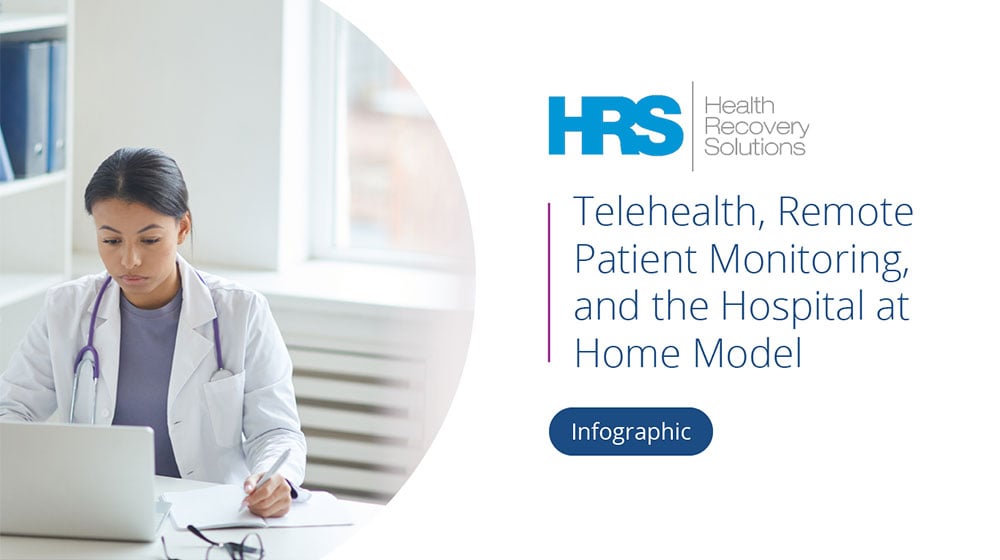
5 Lessons Learned About Hospital at Home Programs
Health Recovery Solutions interviewed two Hospital at Home program leaders at Michigan Medicine and Allina Health who provided helpful insights into their Hospital at Home programs and shared their lessons for success.
Across the past decade, advances in medical technology, changes in reimbursement structures, and the growing need for innovative care delivery models have initiated a shift in the healthcare industry. More recently, the COVID-19 pandemic has sparked new scrutiny of the healthcare system—from the availability of personal protective equipment for frontline workers to managing patients when hospitals are at capacity—ushering in a new era of virtual healthcare that is long overdue.
Telehealth in 2020 was used for so much more than just addressing urgent complaints or COVID-19 screenings. Patients received primary and preventative care, mental health care, even specialty care, like physical therapy, from the comfort and safety of their homes.
Many health systems across the country are taking advantage of the telehealth gains made throughout the COVID-19 pandemic, embracing the use of the Hospital at Home model for their patients. The Hospital at Home is not a new concept. In fact, for countries with single payer systems, the efficacy of the model and its widespread impact has been studied and replicated for decades. In the United States, the uptick has been slower. Today, our healthcare system is at a pivotal point. There is ample opportunity for Hospital at Home programs to gain traction, and with the introduction of CMS’ Acute Care at Home Model, the execution of Hospital at Home programs is not only encouraged, but also incentivized.
By reading the rest of this article, you’ll learn:
- How the U.S. healthcare system has reached a critical tipping point
- Why the Hospital at Home model is being adopted in health systems across the country, and the program’s benefits
- Lessons learned from health system leaders with Hospital at Home programs in place—and what they’re doing to maximize the program’s success
Overview of Hospital at Home
Hospital at Home programs combine in-home and virtual visits with remote monitoring, offering patients timely, hospital-level care in their homes. In countries with single payer systems, this care model has long been considered effective at improving patient outcomes and reducing the total cost of care. Conditions that may benefit from this care model include acute pneumonia, cellulitis, COVID-19, urinary tract infection, dehydration, or exacerbations of chronic conditions, like heart failure or chronic obstructive pulmonary disease (COPD). In short, this care model offers patients who typically require hospitalization the option to receive acute-level care in their home.
As early as the 1970s, the Hospital at Home model has been studied as a method for care delivery—one that results in high-quality care at a lower cost. More than a decade ago, a pilot program launched at Johns Hopkins achieved savings of more than 30% per admission, while delivering equivalent outcomes and fewer complications than traditional hospital care. Since then, multiple studies have determined that, for some patients, the Hospital at Home model can be safer, cheaper, and more effective than care delivered in a hospital setting.
Why the Hospital at Home Model Is Trending Now
Despite decades of research and proven outcomes from leading health systems, models like the Hospital at Home were not previously widely used across the U.S. The reason for this? Prior to the COVID-19 pandemic, telehealth services were largely used for urgent care and transactional visits. COVID-19 ushered in a significant cultural shift—expanding the use of telehealth for comprehensive and relationship-based care across the care continuum.
In 2020, nearly overnight, the use of virtual care skyrocketed as patients sheltered in place. Confronted with shutdowns and chaos, doctors embraced virtual care options and analytics that have been common in other industries for years. As a result, a new spotlight was placed on the Hospital at Home model. In a short period, the benefits of the model were showcased—optimized hospital capacity, reduced length of stay, emergency department diversion, and reduced healthcare costs.
For many providers, offering virtual care as an option for patients has been met with open arms: the current, in-office patient experience can be woeful. Asking patients with acute respiratory illnesses such as COVID-19 or the flu to sit in a crowded waiting room where they can expose themselves and others to infection makes little clinical sense. Similarly, requiring hospital admission and long hospital stays when quality care can be delivered at home (where the patient wants to be) is often illogical. The transformation in attitude and adoption of programs like Hospital at Home has had many contributing factors:
- The Affordable Care Act and the shift to value-based care
- The rising cost of healthcare in the United States
- Technological advances and innovation
- The COVID-19 pandemic and CMS waivers
- Changes in how patients consume healthcare
The Affordable Care Act and the Shift to Value-Based Care
In the past, adoption of the Hospital at Home model has been stymied because Medicare did not previously pay for acute care services provided outside of the hospital for fee-for-service beneficiaries. With the Affordable Care Act, the emphasis on quality of care (rather than quantity of services) has allowed programs providing hospital-level care executed in the home to become a reality. When Medicare would not pay for Hospital at Home program services, health systems that offered the care model worked with their system’s health plans, and commercial plans, to secure reimbursement. Over time, more opportunities for payment have become available.
The Rising Cost of Healthcare in the United States
The U.S. is the most expensive health care system in the world. In 2019, healthcare spending grew by 4.6%, reaching $3.8 trillion or 17.7% of the nation’s Gross Domestic Product (GDP). A function of an aging population and rising healthcare prices, economists have predicted that by 2028, healthcare costs will increase to $6.2 trillion, about 20% of the nation’s GDP.
People age 65 and older, on average, spend more on healthcare than any other age group. There are more individuals falling within that age group living in the U.S.—54 million as of July 1, 2019, according to the U.S. Census Bureau—and that older population is expected to continue to grow year over year.
*These projections do not take into account COVID-19 public health, of which the cost of is not yet clear.
68%
of hospital-based healthcare costs go towards brick-and-mortar overhead
Average cost per hospital admission in the US is
$11,700
making hospitalization one of the most expensive types of healthcare utilizations
One study found that healthcare costs were
52% lower
when acutely ill patients received care at home versus in the hospital
On any given day, about
1 in 31
hospital patients has at least one healthcare-associated infection
The current cost of healthcare in the U.S. is not sustainable—containing costs is essential. With the above statistics in mind, a Hospital at Home program can considerably lower the overall cost of care as it can contribute to shorter length of stay, fewer specialty lab visits, lower readmission rates and lower labor costs.
Technological Advances and Innovation Support Movement Towards Hospital at Home
The COVID-19 pandemic empowered patients to grow more comfortable with remote monitoring and other telehealth tools. But the push for healthcare technology innovation and adoption is long overdue. Telehealth is poised to revolutionize the healthcare industry, dramatically shifting how providers deliver, and how patients receive care.
For providers who want to use telehealth to improve outcomes, cut costs, and enhance the provider-patient relationship, available technology that can meet their needs is no longer a barrier to adoption. For health systems that want to offer hospital-level care in the patient’s home, a strong technology partner can help in every step along the way.
- Biometric Monitoring
- Virtual Visits
- Activity Tracking
- Caregiver Communication Tools
- Symptom Surveys
- Medication Reminders
- Wound Imaging
- Condition Specific Education
Telehealth technology has advanced dramatically in the past decade in terms of the capabilities it offers to both patients and providers alike. Now more than ever, it is a cost-effective care option that is easy to implement and simple to scale-up within a healthcare organization as more complex patient populations arise that could benefit from the Hospital at Home program model.
The COVID-19 Pandemic and CMS Waivers
The COVID-19 pandemic has put the U.S. healthcare system under unbearable strain, but it has also unleashed a wave of innovation. Pressed by the need to keep patients out of the hospital, healthcare providers and leaders have rethought how care is provided. From remote care, to the use of technology, to breaking down barriers across the healthcare system, COVID-19 has accelerated policies that previously were making slow progress.
Prior to the pandemic, arguably the biggest barrier to adoption of the Hospital at Home model was lack of payment. The Centers for Medicare & Medicaid Services (CMS) and private payers did not pay for hospital care delivered at home and were strict on payment for telehealth services. In an age when rising numbers of (often elderly) patients have multiple health problems—and when the U.S. healthcare system is trying to focus on prevention rather than merely treatment—healthcare regulations were overdue for change.
The COVID-19 pandemic created an urgent and essential need to keep patients out of the hospital, prompting Medicare to allow providers to bill for acute care treatments at home. However, the largest change from Medicare has been the introduction of the Acute Hospital Care at Home waiver, which provides eligible hospitals with regulatory flexibilities to treat eligible patients in the home.
[The Acute Hospital Care at Home program] is designed for patients who meet acute inpatient or overnight observation admission criteria for hospital-level care…the patient’s home is considered part of the hospital during the admission.- Centers for Medicare & Medicaid Services
For the time being, health systems can only offer telehealth and remote care services that will be paid for by Medicare, commercial carriers, or health system plans. Although the Acute Hospital Care at Home waiver is temporary—currently in place through 2021—many experts believe that the waiver (or something similar) will become a permanent fixture going forward.
Prior to the Acute Care at Home waiver, health systems secured reimbursement for Hospital at Home program services through commercial carriers, the health system plan and Medicare Advantage, or through bundled payments. Commercial payers are now in the position to create payment mechanisms for Hospital at Home programs in the future.
Changes in How Patients Consume Healthcare Fuels Telehealth Adoption
Over the past decade, healthcare consumers started exploring alternative mediums and platforms for receiving care—focusing heavily on convenience and the need for autonomy in self-care management. During the COVID-19 pandemic, home healthcare was a big winner as out-of-hospital, at-home services across the care continuum increased dramatically. Patients responded positively toward being at home for activities like consultation and diagnostics.
This shift in preference towards home-based healthcare makes sense. Allowing patients to stay in the comfort of their homes (as opposed to a crowded hospital) keeps patients from being exposed to other illnesses in a hospital setting. It’s also cost-effective to manage patients at home and gives providers insight into both the patient’s condition and lifestyle.
How Does the Hospital at Home Model Work?
Every Hospital at Home program is different. They vary based on patient population and available resources. The two most common models are Emergency Department Diversion and Early Discharge. The difference between them? How the patient enters the program.
1
Model 1: Emergency Department Diversion
Goal: Increase hospital capacity
The patient is identified as a potential candidate for the Hospital at Home program when they are in the ED or inpatient hospital bed. They qualify for admission into the program based on having one of the targeted illnesses—e.g., exacerbation in a chronic condition, UTI, cellulitis, COVID-19.
2
Model 2: Early Discharge
Goal: Reduce length of stay (LOS) in the hospital
Patient is already being treated at the hospital for a condition and qualifies for early discharge. For next steps:
- The patient receives an in-person physician evaluation to assess whether they are a candidate for the program using predetermined criteria.
- If deemed eligible, the patient is provided with the remote patient monitoring and telehealth platform in the hospital, or the technology is sent directly to the patient’s home via mail, or the technology is delivered from the Hospital at Home nurse.
- The patient is transferred to their home for care.
- At home, the patient receives nursing care once daily—either in person or remotely—and two in-person visits daily via RNs or mobile integrated health paramedics
- Each day, the patient engages with telehealth tools to stay in communication with their providers and monitor their symptoms.
- The patient is treated until they are stable for discharge, which is determined by preset discharge criteria.
5 Lessons Learned About Hospital at Home Programs
 Health Recovery Solutions’ health system partners are leading the charge when it comes to innovation, embracing Hospital at Home programs as a way to improve how healthcare is delivered. In response to the COVID-19 pandemic, many health system leaders quickly pivoted strategy to implement a technology-forward approach to care delivery that never compromised on quality of care.
Health Recovery Solutions’ health system partners are leading the charge when it comes to innovation, embracing Hospital at Home programs as a way to improve how healthcare is delivered. In response to the COVID-19 pandemic, many health system leaders quickly pivoted strategy to implement a technology-forward approach to care delivery that never compromised on quality of care.
For example, many HRS partners implemented Hospital at Home programs to facilitate early hospital discharge for COVID-19 patients (and other conditions), to monitor lower-acuity COVID-19 patients at home, and to avoid hospital admissions for patients needing acute hospital care (that could be treated in the home).
In the past year, with the high-volume of Hospital at Home programs that have been deployed, there have also been many lessons learned. Every health system has a unique workflow for staff, patients, caregivers, and the system as a whole. We spoke with two program leaders at Michigan Medicine and Allina Health to understand their Hospital at Home programs, and the lessons they learned during the process.
The Future of the Hospital at Home Model as a New Hospital Unit
Hospital at Home programs are undoubtedly the care delivery model of the future…they leverage the highest quality technological capabilities available, [and offer] lower-cost, safe, high-quality hospital-level care in the home.Rachel Kuhnly
Allina Health
Over the past two years, a force outside of the healthcare system—a novel virus—ushered in a wave of change and innovation, forcing health systems to adjust processes and adopt the use of technology to enable better quality of care for patients. A new wave of connections was forged across health systems to support care delivery, and historical barriers were broken.
Looking ahead to the next pandemic—and to the future care of patients, all the time—there’s a need for health systems across the country to embrace these changes and explore Hospital at Home programs. The patient’s home should be considered an extension of the hospital, serving as a place for high-quality care to be delivered (for those patients that qualify), acting as an integral part of the larger health system.
Now more than ever, Hospital at Home programs are feasible and cost-efficient to the larger health system:
- Technology continues to innovate, opening new doors to more patient populations
- CMS waivers are in place, making the Hospital at Home model financially and logistically possible from a reimbursement and billing perspective
- Patients are adopting the Hospital at Home model more than ever before, reinforcing that a patient’s home can serve an extension of the hospital to deliver high-quality care
- Clinicians understand the efficacy of the Hospital at Home model and are open to the value home-based care offers to patients
There is already widespread evidence that Hospital at Home programs are successful. Health systems must look to those who have implemented programs already, analyzing what other organizations have done to plan for (and set up) a Hospital at Home program, what their organizational challenges were, and how they’ve overcome those issues.
Considering launching a Hospital at Home program?
Health Recovery Solutions offers the support you need. HRS has clients who are constantly standing up new Hospital at Home programs, so we can share lessons learned. HRS also has a talented and trusted clinical services team—staff that have served in various departments across hospitals and health systems and who understand the “boots on the ground” perspective for how to successfully launch (and maintain) a Hospital at Home program using remote patient monitoring and telehealth.


